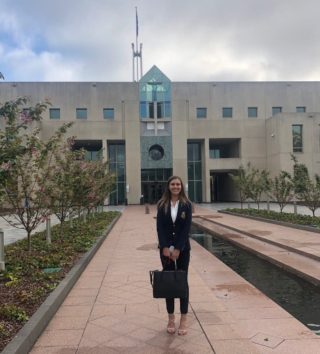NAARDEN, the Netherlands — Midway through “The Sisters of Auschwitz,” Roxane van Iperen’s book on two Dutch Jewish sisters who aided dozens of people during World War II, there is a moment of merriment that one doesn’t usually expect from a Holocaust narrative.
In a neighborhood “crawling with fascists,” she writes, the sisters, Janny and Lien Brilleslijper, organized a celebration of Yiddish culture at their countryside estate in Naarden, about 30 minutes from Amsterdam.
“There is dance, music, song and recitation,” van Iperen writes. “Simon drums, Puck plays the violin and Jaap builds Kathinka a little piano. Lien uses the death mask for a Yiddish story.” The attendees “quietly dissolve into the night — without a single Nazi, German soldier or overzealous neighbor even noticing they were there.”
How did this take place in 1943, during the most lethal phase of Jewish deportations from the Netherlands to extermination camps? “Luck, I guess. A lot of luck,” van Iperen said in an interview. “For a short while, nothing was very public, and after a while, people knew, the milkman and the baker knew, but for one reason or another they chose to keep silent.”
Van Iperen now lives in that house, whose name, ’T Hooge Nest, or the High Nest, appears on its facade. That was also the Dutch title of her book, which was published by Lebowski Publishers in 2018. It became a best seller in the Netherlands, spending more than 130 weeks on the national Bestseller 60 list.
On Tuesday, Harper Paperbacks is publishing it in the United States with an English-language translation by Joni Zwart, and it is slated for release in at least 11 other countries.

When van Iperen moved into the house in 2012 with her husband and three children, she was working as a corporate lawyer in Amsterdam and writing on the side. Her first book, “Schuim der Aarde” (“Scum of the Earth”), a novel, was published in 2016. But when she began renovations, the house started to speak to her.
“We tear away carpets and in almost each room we discover trap doors in the wooden floors, hiding places behind old paneling,” she writes in her preface. “There we find candle stumps, sheet music, old resistance newspapers.”
Then van Iperen started hearing rumors. Some people said the High Nest had been a Dutch Nazi stronghold; others said the resistance had been based there. Unsure what to believe, she delved into local archives and discovered the story of the Brilleslijper sisters.
In February 1943, eight months after the Nazis began their process of mass “Jewish removal” from Dutch cities, the Brilleslijper sisters and their families secured the property using fake names and falsified papers. Descended on their father’s side from “a circus family of traveling, Yiddish-speaking musicians,” and on the mother’s from “devout Frisian Jews; tall, sullen people,” the two girls had been raised in and “by” Amsterdam’s Jewish Quarter in a close-knit, music-loving family, van Iperen writes.
Lien became a dancer, meeting her partner, a German musicologist and concert pianist, before the war. Janny, a factory seamstress, married a civil servant. Both couples had children, and, determined to stay together, they hid three generations of their family in the High Nest.
The house also supported several other Jewish people and members of the Dutch resistance, who either passed through or settled in to the home’s multiple bedrooms and enormous attic. It became a Jewish cultural oasis, with regular concerts and performances.
The dream crumbled in 1944, when the High Nest was discovered. Its residents were arrested and deported to Westerbork, a Nazi transit camp located in the northeastern part of the Netherlands, then to Auschwitz and Bergen-Belsen, where they would become bunk mates with the diarist Anne Frank and her sister, Margot. The Brilleslijper sisters were among the last to see them alive.
Both of the Brilleslijper sisters survived the Holocaust. Lien died in 1988, followed by Janny in 2003.
To van Iperen, their resistance was a kind of cultural defiance — the fearless celebration of life in the face of extinction — that we don’t tend to hear much about in Holocaust histories.
The notion of Jewish resistance during the Nazi occupation of the Netherlands didn’t get much attention in the aftermath of the war. The more common perception was that Europe’s Jewish population had gone “like sheep to the slaughter,” perhaps because research about the war was still largely based on official German sources, created by a Nazi propaganda machine.
Only about a quarter of the Jews from the Netherlands survived the war — no other western European country suffered a greater proportion loss. For years, the Jews themselves were partially blamed for their own mass murder. The argument went that they were either too compliant with the Nazi regulations or too polite to fight for a scrap of bread, as the historian Louis de Jong described in his 1990 book “The Netherlands and Nazi Germany.”
Van Iperen feels there’s much more to explore in the realm of Jewish defiance, especially in the Netherlands. “There is no national discourse about Jewish culture or Jewish resistance,” she said. “There’s a fascination with it, but there’s no discussion.”

The phrase, “like lambs to the slaughter” originates in the Hebrew Bible as a positive characterization of martyrdom. It was invoked, in an inverted form, during the war to exhort persecuted Jews to armed rebellion (“we will not go as lambs to the slaughter”). The phrase was later used for victim-blaming.
“Jews were victims, yes,” Ben Braber, the author of “This Cannot Happen Here: Integration and Jewish Resistance in the Netherlands, 1940-1945,” said in an interview. “But that doesn’t mean that they underwent their persecution passively. They reacted to the persecution, and were active, in many different ways.”
Braber’s book, published in 2013, explores the extent to which Jewish people were integrated into Dutch society before the war, and how their links to non-Jews or their relative isolation contributed to their ability to resist Nazi oppression. In it, he uses what he describes as a “wide and inclusive definition of resistance.”
About 55,000 Dutch people played some role in resistance activities during the war, but only a small minority — about 2,000 to 3,000 — focused on helping Jews escape the deportations and go into hiding. Those who did were often other Jews, like the Brilleslijpers.
The nonviolent ways that Jews fought the genocide should also be considered part of the resistance, according to Dan Michman, the author of “Holocaust Historiography: A Jewish Perspective.” In that 2003 book, he wrote that the Hebrew term “amidah,” or steadfastness, is used for resistance that preserves and sanctifies life.
“Maintaining your culture, which the National Socialists and their supporters are trying to destroy, is resisting,” Braber said. “The creation and maintenance of Jewish culture, especially Yiddish culture, is a form of resistance.”
One way this took form was defiance against the Nazification of Dutch culture. In 1941, the S.S. administration in the Netherlands created the Nederlandse Kultuurkamer, or Dutch Chamber of Culture. Membership was mandatory for artists and required a declaration of Aryan ancestry. Nothing could be presented, staged or published by nonmembers.
The Brilleslijpers worked against this measure, and their associates in the resistance included many artists, such as the Jewish sculptor Gerrit van der Veen, who set up a secret committee opposed to the Kultuurkamer. But to van Iperen, the sisters resisted on many levels, all of them representing amidah.
“Just saying no to the legal order is the first step,” she said. “To say ‘I’m not obeying, I will not comply.’”
Beyond that, van Iperen added, “At that exact moment of being destroyed as a people, you are actually multiplying the uniqueness of your own culture, the language, the traditions. Culture is what binds a people, even if you’re not religious. It is about creating new symbols to make sense of what’s happening.”
By Nina Siegal/The New York Times






